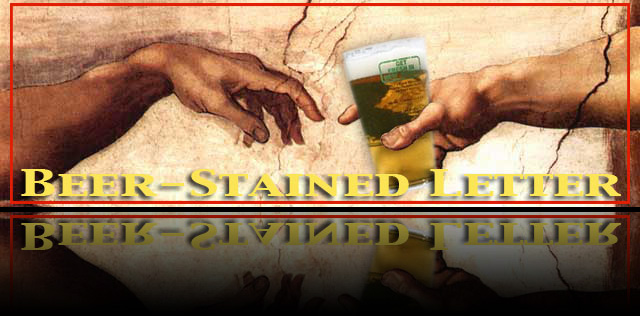Saturday, June 13, 2009
Friday, June 12, 2009
Yesterday's gone
OK, time to cop to something.
Yes, calling Guinness a "yesteryear" beer was a dig at the beer. Sort of.
This comes up by way of email from a former co-worker (from our days at the sweatshop AP news bureau in Trenton) who asked if the Campaign for New Jersey Beer post of Thursday took a swipe at Guinness.
Again, yes. Sort of.
Guinness still tastes good (try the 250th anniversary edition; it's rich and tasty). And in those bars that Rick Reed and other Jersey brewers legitimately complain about, Guinness is a good buy when all the other options are Coors Light, Bud, Michelob Ultra (as in ultra bland) ... The list goes on.
Samuel Adams falls into the same cateogry, a good pint when the rest of the taps aren't worth wasting the calories on. (Jim Koch and Boston Beer, however, deserve a pass. The Samuel Adams brand clearcut the forest to make the road toward better beers, if not proving that you can become the next era of brewing in markets homogenized by Bud, Coors and Miller.)
So why, then, is Guinness yesteryear?
It's a generational thing. Guinness had cult-like status in the late 1980s, early 1990s in several parts of New Jersey. At that time, few bars went to the trouble to deal with that nitrogen-dispensed draft system that allowed Guinness its dense, creamy head and smooth texture. Why bother if you could count your Guinness customers on one hand?
One of the bars in our area, during our Asbury Park Press days, that did go to the trouble was the Drafting Table in Bradley Beach, where you could find Guinness on tap almost 20 years ago. And if memory serves, the Drafting Table occasionally had John Courage Amber on draft, too, a rather inviting British beer at the time.
It doesn't seem like much to sing the praises of either now, given that you can easily get your hands on a fat, heavy bottle of Kasteel Donker, if you're willing to part with 9 bucks. But in 1990, it was a big deal to shift from Heineken to darker beers without having to pass through the doors of a knowledgeable packaged goods store. And it's worth pointing out, too, that at this time, Samuel Adams wasn't a sure thing to find on tap. Or in even bottles behind the bar.
So, indeed, you were hip back then if you even liked Guinness; hipper still if you knew the flavor difference between Guinness on draft and Guinness Extra Stout in the bottle (draft was smoother, thanks to the nitrogen; bottled Extra was a different animal – the fizzy carbonation made the roasted and black patent malts more prickly, almost harsh on the palate). You were a trendsetter if you knew of bars that went the extra mile to carry Guinness on draft.
And Guinness was cool. The John Gilroy advertising illustrations from the 1930s, featuring the menagerie of zoo animals, now played to a new generation in the 1990s on glassware and T-shirts. A former Asbury Park Press co-worker even visited the Guinness brewery in Dublin, returning with gifts for fellow Guinness drinkers, while yet another former co-worker regaled us with tales of pubcrawling in Ireland.
What changed things?
The microbrewing industry finally caught up to New Jersey in the mid-90s. That and Jim Koch challenged you to step up to flavor. And there was portable draft Guinness, the four-pack of cans (those bottles of Guinness draft didn't hit the area market until about 2000-01). Guinness finally found a wider fan base. More taphandles too. Exponentially more compared to 1990. Guinness in the bar and grill these days is as common as salt shakers on the tables, and noticeably absent if it's not on tap. Or at least in cans behind the bar.
Some of that hipness has been lost to time and the increased ranks (see what we mean by generational). And these days, there are plenty of reasons to explore other beers, like that oatmeal cookie stout Triumph occasionally brews – and pours under nitrogen. It's an exceptionally well-done beer.
So is Guinness yesteryear? Respectfully, yes, when the landscape is dotted with so many beer choices, whether from breweries native to the home state (this is a Jersey-centric blog) or the surrounding environs.
But nonetheless, Guinness is still in our fridge. Probably always will be.
Posted by
Jeff Linkous
at
11:04 AM
2
comments
![]()
Labels: Guinness, The Drafting Table, Triumph Brewing
Thursday, June 11, 2009
Campaign for New Jersey Beer*
 Been there, been living it: Think Jersey, drink Jersey.
Been there, been living it: Think Jersey, drink Jersey.
But this like-minded initiative is all about putting a bug in someone’s ear, namely bar owners.
For six weeks now, Rick Reed has used his Friday night sermons from the mash tun at Cricket Hill Brewery to imbue the tour crowds to be foot soldiers in a rebellion to get New Jersey beers on tap at Jersey bars that find it fashionable to crowd their tap space with crappy Coors Light, yesteryear's Guinness, and that god-awful Bass wannabe, Smithwick's.
Those crowds in Fairfield are running about 130- to 150-people strong each week, and Rick’s arming his legions with cards that bear the name of the cause – Campaign for New Jersey Beer – and are to be left with bars and restaurants' wait staff, bartenders or managers. The accompanying text on the cards explains that Garden State brewers make topnotch beers, and bars in New Jersey should have at least one of those beers on tap. It’s a matter of taking pride in something that's made in the state.
On another level, the cards are the equivalent of a polite boycott, since the person leaving the one intends to not patronize the establishment until a Jersey beer gets tap space.
Of course, Rick’s preference is to see Cricket Hill tap handles grow from this action, and he says his draft accounts have jumped by a half dozen since the campaign started. Whether that’s directly related to his foot soldiers and the 1,000 cards that have been passed out so far is anyone’s guess, he says.
But the six new accounts are welcome business, and the awareness served by the cards is undeniably important: Drink Jersey-made beers. They’re local, they’re fresh, and they can hold their own against anything on the store shelves that pours in from New York, Pennsylvania, Michigan, California, Massachusetts, Delaware or Europe.
Meanwhile, this thought came to mind after reading about Carrotmobs in a recent issue of Time magazine. In effect, the movement is a reverse boycott: rewarding businesses with patronage in exchange, in the case of Carrotmobs' requests, for going green.
It would seem like there’s potential for applying that technique to Jersey bars, prevailing en masse upon those places to put the locally made beers on tap and rewarding those bars with regular patronage. Granted, it’s easier, and perhaps more noble, to get businesses to change their light bulbs to CFLs, but we think the idea has potential for Jersey beer somehow.
Who knows, Jersey Maltmobs may be the next story in Time.
* FYI: The graphic above is of our making for the purpose of this post.
Posted by
Jeff Linkous
at
5:43 PM
0
comments
![]()
Labels: Campaign for New Jersey Beer, Carrotmobs, Cricket Hill, Jersey Made Beer, Rick Reed
Roll out the barrel
If you like Ramstein Maibock (we do), then this is something you don't want to miss: Ramstein Maibock, barrel-aged and dry-hopped with fresh Hallertauer hops.
The dry-hopping may break from tradition with a German style beer, but American brewers have been making their mark by rewriting the rules (double IPA, anyone?) and coloring outside the lines. This is one in which High Point Brewing steps in with its expertise and sets the pace.
The tricked-out, limited version of the bock tops the bill for High Point's June open house this Saturday (2-4 p.m.), backed up with the Ramstein flight of Blonde, Dunkel Weiss and Blazing Amber.
And if you're a Ramones, Blondie or Lou Reed fan, the added bonus for Saturday is you can glimpse photos of those performers from their heady days, courtesy of Lower Third Enterprise. The images will be on exhibit and for sale.
You don't need the Reverend Horton Heat to tell you that rock 'n' roll and beer go together like Les and Paul. Meanwhile, we trekked up to Berkeley Heights in Union County on Wednesday for a chat with Trap Rock brewer Charlie Schroeder (more on that very soon) and to visit a brewpub that's worth the two-hour drive from our southern Ocean County shores. (There's a classy polish to Trap Rock that you quickly come to appreciate once past the entrance. And even with a seven-barrel system, Charlie keeps nine house beers flowing, plus a version of one of those on a handpump.)
Meanwhile, we trekked up to Berkeley Heights in Union County on Wednesday for a chat with Trap Rock brewer Charlie Schroeder (more on that very soon) and to visit a brewpub that's worth the two-hour drive from our southern Ocean County shores. (There's a classy polish to Trap Rock that you quickly come to appreciate once past the entrance. And even with a seven-barrel system, Charlie keeps nine house beers flowing, plus a version of one of those on a handpump.)
Pictured is the lovely and gracious Melissa Hudasko, slightly reprising her New York Times pose from last year.
Posted by
Jeff Linkous
at
1:10 PM
0
comments
![]()
Labels: High Point Brewing, Lower Third Enterprise, Ramstein Maibock, Trap Rock
An egregious miscarriagement of taxitude*
Higher state taxes on spirits and wine? Passed on by restaurants to the consumer? Faint ...
There's been a bit of backlash by consumers with QWERTY access, teeing off on restaurants, posting complaints about the threat to pass on a 25 percent increase in those taxes.
It's pretty much misplaced blame to do that. Here's why:
Restaurants don't stay in business by losing money; nor can they eat every rise in their overhead. Last year, anything made with flour cost more because of stupid government policy skewed toward corn as the raw material for ethanol (more corn planted, less of wheat and barley); delivery charges went up when crude oil prices (futures prices, that is) hit the moon; and the list goes on.
The places you dine at were doing what they could last year to manage those headaches. And their migraine has lingered into this year with a downturn in business that they're struggling to make up. (Consider this: You should support your favorite restaurants if you can. The patrons they stand to lose aren't just someone else; they are you, too, if you're staying away in protest.)
So when New Jersey, meaning the Corzine administration, popped the cork on this tax increase and poured everyone a round of pay-more, well anyone who had just finished a snifter of Courvoisier on March 10th could have envisioned restaurants being stuck with few options.
And if you're a beer drinker, don't think you're getting an automatic pass at the tap just because beer was left off Corzine's tax menu. To keep from scaring away patrons, restaurants and bar owners could spread the pain across the pricing board – pints of beer, entrees, appetizers – and not just jack up the tab for a shot of Applejack. (It makes for good, kneejerk rabble rousing for industry groups to insinuate that prices by the drink will rise in proportion to the tax increase.)
But the point remains: Don't blame the restaurant owners for trying to stay in business. Blame the Legislature and a succession of governors on both sides of the political aisle for missteps and miscues, and a legacy of avoiding doing what's right.
* From The Simpsons, 9th season, episode 20, The Trouble With Trillions
Posted by
Jeff Linkous
at
11:14 AM
0
comments
![]()
Labels: Jon Corzine, New Jersey Legislature, wine and liquor taxes
Monday, June 8, 2009
Rapid response ...
 As in yours is needed. This missive from the Brewers Association tumbled into the email queue today.
As in yours is needed. This missive from the Brewers Association tumbled into the email queue today.
Like we have said, the battle has been joined, and the Brewers Association is conscripting craft beer drinkers to act like a militia and speak out, state by state, against higher excise taxes by writing their lawmakers on Capitol Hill.
New Jersey's own Bob Menendez is on the Senate Finance Committee. One more time, here's his email. And the blue graphic shows addresses for his New Jersey and DC offices. The best approach is a two-pronged one, meaning don't just email, but send the same comments via conventional mail as well. Also, when you write, cite. Pull information from the Brewers Association's arguments and point out that higher federal taxes will hurt New Jersey craft brewers, who are a source of jobs and state and local taxes, regardless of how many jobs or however much those taxes paid at home are.
The best approach is a two-pronged one, meaning don't just email, but send the same comments via conventional mail as well. Also, when you write, cite. Pull information from the Brewers Association's arguments and point out that higher federal taxes will hurt New Jersey craft brewers, who are a source of jobs and state and local taxes, regardless of how many jobs or however much those taxes paid at home are.
It's also worth pointing out – as we have before – that beer, wine and liquor* have been paying Uncle Sam's bills for several decades. It would be unfair and too easy for Congress to tap that source again. But the unfortunate stigma that beer, wine and liquor have attached to them make them the easy – even vulnerable – target. DUI, underage drinking and alcoholism are not solved through higher taxes (nor should any thinking person accept those as reasons to fund healthcare reforms so long as cigarettes are a commercially available product in this country).
If you're over 45, you probably remember when soft drinks came, not in Big Gulps and 20-ounce containers, but in 12-ounce bottles (or even 6 and 10 ounces from vending machines!) and that fast food was a sometimes food, served in modest portions, and not an everyday food. And it should mean something to healthcare reformers, Capitol Hill and the Obama administration that five years ago McDonald's, to its credit, dumped its Super Size menu, thanks, in no small part, to blow-back from those outsized portions making outsized Americans. Oversized sodas and fatty, prepared or prepackaged foods own a piece of the erosion of the nation's overall health and their industries should be asked thusly to share a tax burden.
*Awhile back, Pennsylvania beer writer Lew Bryson put forth the idea that calling beer, wine and liquor alcoholic beverages is an unfortunate choice of words, unfairly tying them to negative connotations of alcoholics and alcoholism. (Lew didn't pontificate; he just pointed out his preference to not phrase references to the beverages in that way.) We share his point of view: Hence, beer, wine and liquor.
Posted by
Jeff Linkous
at
12:02 PM
0
comments
![]()
Labels: healthcare reform, Sen. Robert Menendez
Rapid deployment
 Last year, it wasn't until the second week of July that cones took shape on our Centennial bines.
Last year, it wasn't until the second week of July that cones took shape on our Centennial bines.
This season, it's been surprisingly fast: the first week of June. These are early ones, but cones all the same.
Posted by
Jeff Linkous
at
9:01 AM
0
comments
![]()
Labels: centennial hops, Growing hops, Growing Hops in New Jersey
















